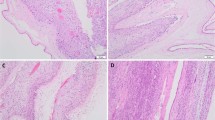Abstract
Purpose
Chorioamnionitis, or intraamniotic infection, is a common condition, carrying an increased risk of intrapartum cesarean delivery (CD). The morbidity related to chorioamnionitis is more common in those undergoing CD, as compared to those with successful vaginal delivery. We aimed to examine the risk factors associated with CD among women with chorioamnionitis.
Methods
A retrospective cohort study from a tertiary medical center. We included women at term carrying a singleton gestation with suspected chorioamnionitis undergoing a trial of labor between 2011 and 2019. The primary outcome was the mode of delivery.
Results
Data from 1436 women with chorioamnionitis were analyzed; 1288 (89.7%) were nulliparous. Overall, 1064 (74.1%) delivered vaginally, and 372 (25.9%) by CD. The rate of CD was significantly higher in nulliparous as compared to parous parturients (26.9% vs. 16.9%, P = 0.008), and in those with fever onset at latent phase as compared to those in whom fever appeared at active labor (≥ 6 cm) (47.0% vs. 18.1%, P < 0.001). In a multivariate analysis, CD was positively associated with: onset of fever at latent phase (aOR [95% CI] 4.75 (3.54, 6.32), P < 0.001), nulliparity (aOR [95% CI] 3.25 (1.98, 5.34), P < 0.001), maternal age (aOR [95% CI] 1.52 (1.10, 2.09), P = 0.01) and birth weight (aOR [95% CI] 1.23 (1.04, 1.44), P = 0.01).
Conclusion
Women with chorioamnionitis had a high rate of CD. Nulliparity and onset of fever prior to active labor were the strongest independent predictors of CD. It remains to be determined whether those deemed at high risk for failed trial of labor, should undergo CD earlier in the course of labor to improve chorioamnionitis-related outcomes.

Similar content being viewed by others
References
Tita A, Andrews WW (2010) Diagnosis and management of clinical chorioamnionitis. Clin Perinatol 37:339–354
Kim CJ, Romero R, Chaemsaithong P, Chaiyasit N, Yoon BH, Kim YM (2015) Acute chorioamnionitis and funisitis: definition, pathologic features, and clinical significance. Am J Obstet Gynecol 213:S29–52
Higgins R, Saade G, Polin RA et al (2016) Evaluation and management of women and newborns with a maternal diagnosis of chorioamnionitis: summary of a workshop. Obstet Gynecol 127:426–436
Bommarito KM, Gross GA, Willers DM, Fraser VJ, Olsen MA (2016) The effect of clinical chorioamnionitis on cesarean delivery in the United States. Health Serv Res 51:1879–1895
Venkatesh K, Glover AV, Vladutiu CJ, Stamilio DM (2018) Association of chorioamnionitis and its duration with adverse maternal outcomes by mode of delivery: a cohort study. BJOG 126:719
Rouse D, Landon M, Leveno KJ et al (2004) The maternal-fetal medicine units cesarean registry: chorioamnionitis at term and its duration—relationship to outcomes. Am J Obstet Gynecol 191:211–216
Committee on Obstetric Practice HR, Puopolo KM, Beigi R, Silverman NS, El-Sayed YY (2017) Committee opinion No. 712: intrapartum management of intraamniotic infection. Obstet Gynecol 130:e95–101
ACOG Practice Bulletin No (2019) 202: Gestational hypertension and preeclampsia. Obstet Gynecol 133(1):e1–e25
ACOG Practice Bulletin No (2018) 190: Gestational diabetes mellitus. Obstet Gynecol 131(2):e49–e64
Venkatesh K, Hughes BL, Grotegut CA et al (2020) Preoperative cefazolin rather than clindamycin or metronidazole is associated with lower postpartum infection among women with chorioamnionitis delivering by cesarean delivery. Am J Obstet Gynecol MFM 1:100074
Duff P, Sanders R, Gibbs RS (1983) The course of labor in term patients with chorioamnionitis. Am J Obstet Gynecol 147:391–395
Rauk PN, Friebe-Hoffman U (2000) Interleukin-1β down regulates the oxytocin receptor in cultureduterine smooth muscle cells. Am J Reprod Immunol 43:83–89
Mark SP, Croughan-Minihane MS, Kilpatrick SJ (2000) Chorioamnionitis and uterine function. Obstet Gynecol 95:909
Satin AJ, Maberry MC, Leveno KJ et al (1992) Chorioamnionitis: a harbinger of dystocia. Obstet Gynecol 79:913
Silver RK, Gibbs RS, Castillo M (1986) Effect of amniotic fluid bacteria on the course of labor in nulliparous women at term. Obstet Gynecol 68:587
Mogren I, Lindqvist M, Petersson K et al (2018) Maternal height and risk of caesarean section in singleton births in Sweden—A population-based study using data from the Swedish Pregnancy Register 2011 to 2016. PLoS ONE 13(5):e0198124
Kominiarek MA, VanVeldhuisen P, Gregory K, Fridman M, Kim H, Hibbard JU (2015) Intrapartum cesarean delivery in nulliparas: risk factors compared by two analytical approaches. J Perinatol 35(3):167–172
Read AW, Prendiville WJ, Dawes VP, Stanley FJ (1994) Cesarean section and operative vaginal delivery in low-risk primiparous women, Western Australia. Am J Public Health 84(1):37–42
Venkatesh KK, Jackson W, Hughes BL et al (2019) Association of chorioamnionitis and its duration with neonatal morbidity and mortality. J Perinatol 39:673
Funding
This research received no external funding.
Author information
Authors and Affiliations
Corresponding author
Ethics declarations
Conflict of interest
The authors report no conflict of interest.
Ethical approval
An institutional review board approval waiving informed consent was obtained for this retrospective study (# 6249-19-SMC, 07/01/2019).
Additional information
Publisher's Note
Springer Nature remains neutral with regard to jurisdictional claims in published maps and institutional affiliations.
Rights and permissions
About this article
Cite this article
Rottenstreich, A., Levin, G., Tsur, A. et al. Chorioamnionitis at latent phase more than doubles the risk for cesarean delivery compared to chorioamnionitis at active phase. Arch Gynecol Obstet 303, 905–910 (2021). https://doi.org/10.1007/s00404-020-05815-9
Received:
Accepted:
Published:
Issue Date:
DOI: https://doi.org/10.1007/s00404-020-05815-9




